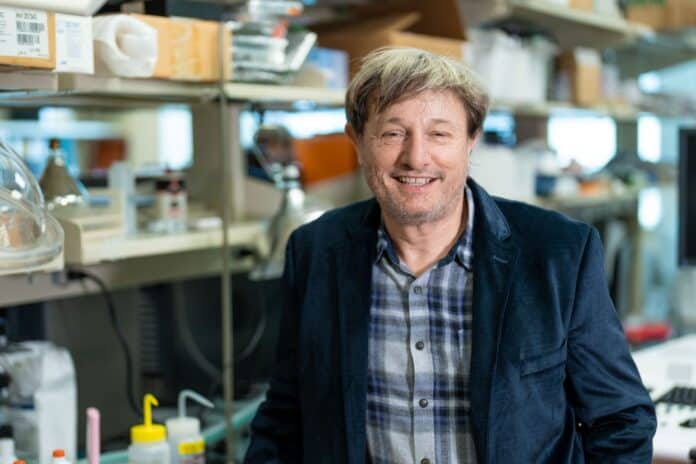Roanoke’s reputation as a great place for biotech was in for a watershed moment when Rob Gourdie brought his trademark curiosity and passion to the Fralin Biomedical Research Institute at VTC in June 2012.
A cell biologist, Gourdie focuses on how cells in the body communicate with each other and applies that knowledge to treat disease.
Along the way, he has been awarded multiple research grants from the National Institutes of Health (NIH) to support his fundamental research program at the Fralin Biomedical Research Institute and has started three biotechnology companies, including two that are blossoming in the Roanoke area, to advance the discoveries made in his lab to applications and commercialization.
He will cap a journey that has taken him from the University of Aukland, New Zealand, to Virginia Tech when he opens the 2025-26 Maury Strauss Distinguished Public Lecture Series at the research institute on Thursday, Sept. 18, at 2 Riverside Circle in Roanoke.
Michael Friedlander, executive director of the Fralin Biomedical Research Institute at VTC and Virginia Tech’s vice president for health sciences and technology, invited Gourdie to open the season and mark the research institute’s 15th year in Roanoke.
“It has been a tremendous ride so far with the fledgling institute growing to over 700 employees and students with a current active extramural grant and contract portfolio of almost a quarter billion dollars and over $1.7 billion in cumulative local economic impact,” Friedlander said. “More importantly, many discoveries have come from the institute that are already offering new hope through preventions, diagnostics, and treatments for a variety of disorders that impact lives of Virginians, and the nation and the world. Dr. Gourdie is truly the quintessential embodiment of those contributions and excellence that have made this possible for our community.”
As head of the institute’s Center for Vascular and Heart Research, Gourdie leads groundbreaking studies in cardiovascular medicine — one of several areas in which the institute is pushing frontiers.
“Heart disease is the world’s leading killer, claiming nearly 18 million lives every year, and yet advances in prevention, treatment, and reparative medicine mean millions more are living longer, healthier lives,” Friedlander said. “We are honored to have Dr. Gourdie share his insights on the future of cardiovascular medicine, particularly at this 15th year of the biomedical research enterprise in Roanoke.”
The research institute, along with the Virginia Tech Carilion School of Medicine, opened in 2010 through a partnership between Virginia Tech and Carilion Clinic.
Gourdie is recognized worldwide for his research on how heart cells connect and communicate. His lab discovered the perinexus, a tiny structure next to the cell-to-cell junctions in the heart. The perinexus plays an important role in ephaptic conduction — a process where electrical signals spread between heart cells through very close contact, even without the usual connecting channels.
These findings have changed how scientists understand the way the heartbeat is coordinated and opened new possibilities for treating irregular heart rhythms and heart disease.
In the process, Gourdie has created imaginative approaches to prevent damage from heart attacks as well as new approaches to chemotherapy and radiation treatment form cancer, to heal chronic wounds, and to treat aggressive forms of cancer. His work exemplifies how findings from rigorous basic biomedical research can often open doors to better understanding and treatments of multiple diseases – an area in which the United States has led the world with the strong support of funding through the NIH.
His lab also has pioneered the extraction and development of organic nano-capsules, called exosomes, that can deliver fragile peptide drugs to the heart, brain, and other difficult-to-reach tissues.
Gourdie describes himself as an “intrapreneur” — someone who builds innovation from within an institution.
“I work within the university but try to take discoveries beyond the lab bench, and that involves a different kind of thinking than is traditionally associated with academia,” Gourdie said.
Gourdie sees translational research – moving discoveries from the lab into practical use – as an important piece of the biomedical innovation ecosystem.
“Researchers have an ethical obligation to engage in technology transfer, ensuring taxpayer-funded discoveries benefit public health,” he said.
About 20 years ago while at the Medical University of South Carolina, Gourdie and postdoctoral fellow Gautam Ghatnekar identified a compound, alphaCT1, that modulates cell membrane channels linked to a cell’s biological response to an event in a nearby cell.
To their surprise, it also promoted wound healing, reducing inflammation and helping close chronic ulcers such as those caused by diabetes. Seeing its potential, the two founded FirstString Research Inc., now operating under the name Xequel Bio Inc., which is advancing alphaCT1 toward clinical use.
Since joining the institute, Gourdie founded Tiny Cargo Co., which isolates exosomes from cow’s milk into nano-capsules for drug delivery.
Tiny Cargo recently leased a 10,800-square-foot warehouse in the Roanoke area to begin manufacturing exosomes at scale. One product from the facility will be Xolacta, a drug to treat side effects of radiation.
With Samy Lamouille, another faculty research team leader at the institute, Gourdie co-founded Acomhal Research. The company is focused on a protein needed for cell-to-cell communication and used by cancer cells to divide and grow, even after chemotherapy. The company’s patented drug disrupts the interactions, potentially offering a potent new tool for battling cancer.
Gourdie received his doctoral degree in physics at the University of Cambridge in Aukland. He was a tenured professor at the Medical University of South Carolina before joining the research institute in 2012. He is the founding director of the institute’s Center for Vascular and Heart Research.
In 2022, he became the first Virginia Tech researcher to receive an Outstanding Investigator Award from the NIH. In addition, his contributions to innovation have been recognized by his election to the National Academy of Inventors.
Gourdie also is the Commonwealth Research Commercialization Fund Eminent Scholar in Heart Reparative Medicine Research and the Heywood Fralin Professor at the Fralin Biomedical Research Institute at VTC. He also holds faculty appointments in biomedical engineering and mechanics in the College of Engineering and in emergency and internal medicine in the Virginia Tech Carilion School of Medicine.
Gourdie’s presentation is free and open to the public at 2 Riverside Circle in Roanoke on Thursday, Sept. 18. Doors open at 5 p.m. with an informal reception and the presentation begins at 5:30 p.m. The lecture will also be available via Zoom and YouTube.
The lecture series is named for Maury Strauss, a longtime community benefactor and businessman who supported biomedical research with the goal of energizing the local economy and improving quality of life in our neighborhoods and around the world.
Other speakers for the 2025-26 series include:
- Jennifer Munson, director of the institute’s Cancer Research Center in Roanoke, who will discuss new approaches to tracking brain cancer cells
- Teresa Lambe, professor of vaccinology and immunology at the University of Oxford who co-designed the Oxford/AstraZeneca vaccine against COVID-19
- Holly Ingraham, professor of molecular pharmacology at UC San Francisco and member of the National Academy of Science who will discuss brain-body cross-talk in women’s health
- Vivian Lee, executive fellow at Harvard Business School and member of the National Academy of Medicine who will discuss digital solutions to healthier lives
- Lewis Lanier, American Cancer Society professor from UC San Francisco and member of the National Academy of Sciences who will discuss the golden age of immunology
- John Morris, distinguished professor of neurology at Washington University School of Medicine, who will discuss a new era for Alzheimer’s disease diagnosis and treatment


